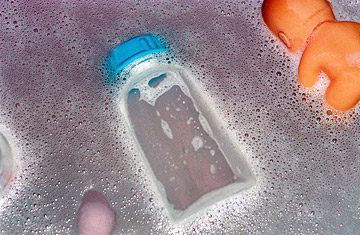
They're in the toys children play with, on the foods they eat and in the air they breathe. Each year, about 27 trillion lb. (12 trillion kg) of chemicals are produced in or imported into the U.S., and pediatricians say there is precious little research regarding the effects that the bulk of these compounds may have on children's development.
That's why the American Academy of Pediatrics' Council on Environmental Health has urged the government to require more testing and evaluation of the tens of thousands of chemicals children are exposed to daily. The primary law regulating chemicals in the U.S., the Toxic Substances Control Act (TSCA) of 1976, is outdated, the academy's experts said, calling it "ineffective" in a policy statement. Only five chemicals--including dioxin, asbestos and polychlorinated biphenyls--have been regulated under the act in the past three decades, and the TSCA does not require any chemical manufacturer to conduct premarket testing of its products' effects on human health.
Increasingly, however, studies find that widely used chemicals like bisphenol A, phthalates and pesticides are associated with long-term health problems in children. Indeed, days before the academy released its policy statement, three research groups independently reported that babies with higher prenatal exposure to pesticides had lower IQs in childhood than those born to women with less exposure. Most of the contact, said the scientists, came from pesticide residue on fruits and vegetables.
Still, while studies show that virtually all children and adults have evidence of such chemicals in their systems--they regularly appear in tests of blood, tissues and body fluids like breast milk--that doesn't tell us which ones are actually doing harm. To figure that out, the council urged health officials to require chemical makers to safety-test their products before releasing them to the market. Only then will we know whether the convenience of all these new products is worth the cost.
PARKINSON'S
Group Therapy
The one-on-one doctor-patient office visit is a staple of our health care system. But a new study finds that pooling several patients into a single group session may make the visit more productive, not to mention more cost-effective--at least for Parkinson's patients.
Researchers report that 13 patients who saw their physician together once every three months for a year recorded no difference in satisfaction with their visits from those who saw their doctor individually. In addition, the group patients showed no difference from the controls in depression, Parkinson's symptoms or quality of life.
That's encouraging, because patients said the group sessions, which lasted 90 min. (compared with 30-min. solo visits), gave them more time to ask questions of a medical authority. Likewise, the physicians said the longer visits gave them more opportunity to observe important changes in their patients' conditions.
But the study authors say group sessions shouldn't replace individual visits. Instead, they may be used as a powerful supplement to help doctors and patients alike get more out of their encounters.
MALARIA
The Secret To Drug Resistance
